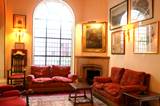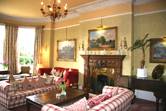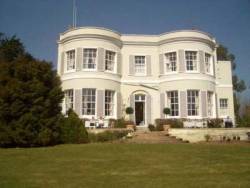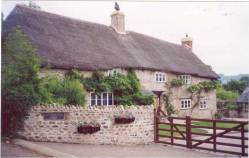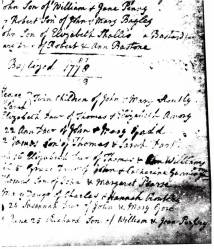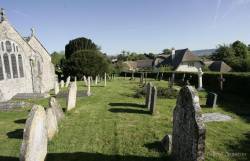

 Richard Percy of Deer Park, Devon
Richard Percy of Deer Park, Devon 


General Notes
Said to be a son of Hugh Percy 2nd Duke of Northumberland.
Family tradition says that he lived at Deer Park in Devonshire, near Honiton, England.
There are 2 family stories about Richard:
#1 - Told by Louisa Emma Moore is that Richard was gored to death by a bull in 1842.
Therefore Richard predeceased his older brothers who became the 3rd and 4th Dukes of Northumberland.
#2 - Told by Edwin Gwynne Moore quoting Thomas Fraunceis Moore is that the real hidden story is that Richard Percy fought a duel, and wounded his opponent (who later died). This brought disgrace and a possible criminal charge to himself, and so he was told by the family to leave England. As a result he, his wife Louisa and the children went to America for a time. He later died from his wounds in the duel. As a result of this disgrace, Richard was removed from the official Percy family records - and Richard changed his name to Pursey (as seen in the marriage certificate of his daughter Louisa Matilda when she married Thomas Webber Moore). Or perhaps this was an example of the typical loose spelling of surnames at the time?
The remaining family then migrated to Australia in c.1853.
Note that Edwin Gwynne Moore says he got the real story because his father Thomas Edwin Moore was the eldest son and heir of Thomas Fraunceis Moore.
It is also possible that Richard was an illegitimate son of Hugh Percy, 2nd Duke of Northumberland. Hugh was known to have many illegitimate children, and records of these are not kept at Alnwick Castle - they only keep records of the "main branch" of the Percy family, according to a letter from Alnwick Castle to Ralph Ballard dated 16 June 2005.
Records transcribed by the Somerset and Devon Family History Society show:
Richard Purssey baptised 25 June 1778 to William and Joan at the Church of the Blessed Virgin Mary at Stogumber.
This appears to be our mysterious "Richard Percy".
If so - who was Richard's real biological father?
Was the Duke of Northumberland his biological father - and perhaps William did the right thing by Joan by claiming Richard as his own?
Or is Richard perhaps truly the son of William and Joan Purssey?
Stogumber parish records show that Richard Purssey married Harriett Fraunceis Griffith on 6 September 1808 at Stogumber church.
A sworn affidavit from Harriet Francis Pursey dated 29 August 1849 (2 years before her death) states that her husband Richard Pursey died on 9 July 1828.
*** Mr. David Turner of West Somerset has provided to me a copy of the original Baptism Register and the Marriage Register for Richard Purssey - these records confirm the accuracy of the information here.
Records of Stogumber indicate that Richard was a significant local landowner, and a man of some means and standing.
For example the 1814 Poor Rates for Stogumber (available online) list Richard Pursey as the occupier of Purseys Farm and Tuckers Farm.
A map of Stogumber noted as "post-medieval and 19th century" available online at http://www1.somerset.gov.uk/archives/hes/downloads/EUS_StogumberMapC.pdf
shows "Purseys Farm" on Station Road - on the way to the local cricket ground.
Pursey's Farm is still in existence in Stogumber - it is located just off Station Road, opposite Pickpurse Lane. This is a 15th century thatched, cob-built cottage. Cob is a composition of clay, gravel, and straw, used for building walls. Photo by John Grayson taken 2010 - see http://commons.wikimedia.org/wiki/File:Pursey's_Cottage,_Stogumber_-_geograph.org.uk_-_1766357.jpg and licence condtions at http://creativecommons.org/licenses/by-sa/2.0/
In addition the will of Richard's wife, Harriett, was proved on 23 April 1851 (available online at The National Archives), and shows that she was resident at Wellington Street, Hoxton Old Town, Middlesex - at that time an outer suburb of London which had a number of old mansions, but later became a slum. It is quite possible that Richard and Harriett in later life also maintained a house in London, as a fashionable thing to do. Hence it would be consistent for them to own this house in Hoxton Old Town as a genteel (at that time) part of outer London, as well as country property in Stogumber.
To complicate matters there is a burial record of a Richard Pursey at the church of St. Martin In The Fields, Westminster borough, London, on 18 July 1831 - this man's age is given as 53 and year of birth as about 1778 - which also fits "our" Richard Pursey.
If this is indeed "our" Richard Pursey, then his burial at such a major church as St. Martin In The Fields would suggest that he was a man of substance with significant social standing.
*** However Nic Pursey has in November 2013 pointed out the record of burial on 15 July 1828 at Gittisham parish, Devon, of Richard Pursey, aged 50 (therefore born about 1778 - this fits "our Richard Pursey" much better and is likely the correct record.
The marriage certificate for Thomas Moore and Louisa Matilda Pursey (Richard's daughter) dated 23 March 1848 records Louisa's father as "Richard Pursey - yeoman".
The baptism record for daughter Harriet Pursey in Monkton parish, Devon in 1821 records Richard's occupation as "schoolmaster".
Another question - why does family tradition refer to Richard as "of Deer Park, Devon"?
"Deer Park" is now a private hotel. This Georgian squire's mansion is dated 1721, and set in 30 acres of glorious Devon landscape. The Deer Park Country House Hotel is situated at the end of a long drive just outside the historic lace town of Honiton, a mile or so from the main A30 London to Exeter road. It affords spectacular views of the River Otter.
-
Individual Additional Information
-
Associated external link media/ind00144.htm
 Details of Richard's family with Harriet Fraunceis "Louisa" Griffith
Details of Richard's family with Harriet Fraunceis "Louisa" Griffith
Page last modified
This page is within a frameset. View the entire genealogy report of Percy of Deer Park, Devon families, or surname index of Percy of Deer Park, Devon pedigrees or report summary Percy of Deer Park, Devon heritage from 'Moore, Simpson, Ballard Family Tree - England and Scotland to Australia'.
Gedcom Viewer.
Copyright © 2011 GenoPro Inc. All rights reserved.







